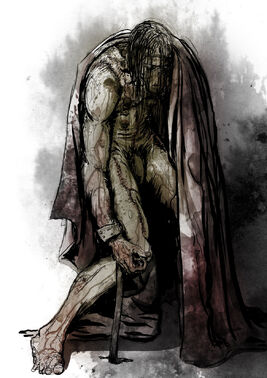
The Creature. Image source: http://t-rexjones.deviantart.com/art/Frankenstein-s-Creation-286829832
Making Monstrous by Fred Botting analyzes Mary Shelley’s Frankenstein, with particular attention to the sexual subjects, the psyche of the creature, and literary artistry that Mary put on display for this novel. Botting extends this conversation by adding in his own critiques, connecting the introduction of electricity to the market during the turn of the nineteenth century, and discussing the implications a novel like Frankenstein and its subsequent adaptations had on that introduction, arguing that the “myth” is what drove electricity to its current height.
Criticism[]
Botting has one major critique of Frankenstein that simultaneously questions the credibility of the novel as a “good” work of literary artistry while also acting as an introduction to what lies at the heart of the Romantic period. Botting Argues that Frankenstein had no unifying meaning. There was no resolution that pointed to the meaning of what the creature or the characters in Frankenstein went through. Botting analyses this flaw through three methods:
Biographical and Literary Influence[]
Botting grounds this branch of his argument on the different influences working upon Mary Shelley. Most prominent of these influences were William Godwin and Percy Shelley. These two authors’ theories, especially Godwin’s, helped to define Romanticism. Frankenstein is, as Botting argues, in direct conversation with this movement. Botting argues that meaning slips out of focus as the novel seeks to explore different ideas brought up by William Godwin and Percy Shelley.
Psychoanalysis of Frankenstein[]
Botting explores the explication of Victor Frankenstein through psychoanalysis, in that Victor’s motives suggest a hidden sexual curiosity, more specifically, Oedipal wishes. This is principally illustrated by his fascination with fathering a new species. This notion of creation is in conversation with the romantic idea of emotional intuition in that Victor reaches for creation by divorcing reason and the idea of "appropriate science"
Gender Roles[]
Botting also explores the representation of gender roles in Frankenstein, which are actually quite subtle. He explores the women in the novel and finds them to be picturesque models of the traditional domestic models of women. They are passive, well-intended mothers and daughters that exist in reasonable happiness within the novel. This happiness, however, is shattered in their obedience and subservient statuses. This element, Botting argues, is also in reflects the fluctuation of gender roles during this time period.
The Creature[]
Fred Botting holds several theories in mind when he considered the Creature in Frankenstein. His first question was on the need for a monster at all. Though monsters were not new additions to literature, his theories explores why Mary Shelley decided to focus an entire novel on one. Botting is also fascinated by the notion of birthday and its scientific backgrounds in relation to the creature.
Monsters and Political Climate[]
During the late Eighteenth century and early Nineteenth century, the plethora of revolutions culminated in an extremely turbulent political climate. At the forefront of this turbulence were the English and French Revolutions. These two political reconstructions had a profound effect not only on the political sphere, but on the literary output of the time as well. Romanticism, while narrowly defined as an opposition to Realism and Naturalism, it can also be seen as a reaction to the political climate of the time. One of these reactions was the introduction of monsters into literature. Botting argues that these monsters, e.g. Mary Shelley’s creature, were a manifestation of this turbulent political climate.
Science in Monsters[]
Botting explores the art in science by explicating the creature’s birth. More specifically, he considers the creature’s birth in regard to alchemy and how it is not actual science, but rather an art. He argues that the creature isn’t something of science due to the sheer lack of proper methodology. Victor employs no scientific standards to go about creating his monster, and he only finds success by attempting it several times. This, Botting argues, denounces it as a science but perhaps affirms it as an art. He argues that the indistinctness in the creature’s birth is what makes it art and not science.
Implications[]
Botting argues that Shelley’s masterpiece Frankenstein sparked a myth about electricity; specifically, the myth that electricity is a spark that can begin life. Shelley herself was by no means a scientist, but following Benjamin Franklin’s thoughts on electricity, she toyed with the idea of its powers. This myth drove the market, albeit slowly at first, towards privatizing electricity. Botting argues that though the reenactments of Shelley’s creature’s birth, the idea to use lightning as a tool became more prevalent. Slowly the myth grew, with Victor’s pseudo-science backing it, that electricity held the key to creation. It became a symbol of human ingenuity and growth towards the future. He argues that though Mary Shelley may not have directly started thought on the possible uses of electricity, she definitely helped to spur it on.
Works Cited
Botting, Fred. Making Monstrous: Frankenstein, Criticism, Theory. Manchester, UK: Manchester University Press, 1991. Print.
